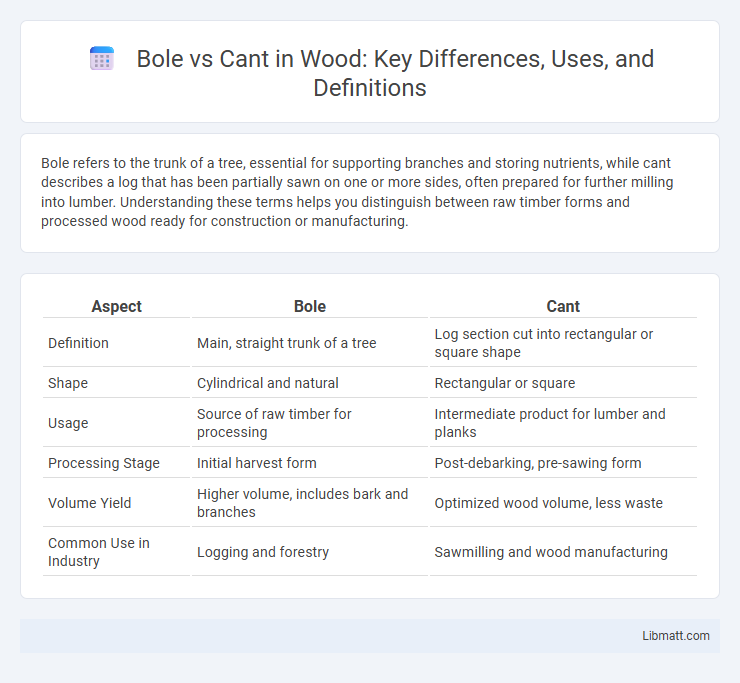Bole refers to the trunk of a tree, essential for supporting branches and storing nutrients, while cant describes a log that has been partially sawn on one or more sides, often prepared for further milling into lumber. Understanding these terms helps you distinguish between raw timber forms and processed wood ready for construction or manufacturing.
Table of Comparison
| Aspect | Bole | Cant |
|---|---|---|
| Definition | Main, straight trunk of a tree | Log section cut into rectangular or square shape |
| Shape | Cylindrical and natural | Rectangular or square |
| Usage | Source of raw timber for processing | Intermediate product for lumber and planks |
| Processing Stage | Initial harvest form | Post-debarking, pre-sawing form |
| Volume Yield | Higher volume, includes bark and branches | Optimized wood volume, less waste |
| Common Use in Industry | Logging and forestry | Sawmilling and wood manufacturing |
Introduction: Understanding Bole and Cant
Bole and Cant are specialized terms in woodworking and forestry, referring to distinct parts of a tree's trunk; the bole is the main, straight section of the tree trunk used for timber, while the cant is a squared or partially squared log prepared for milling. In lumber production, the bole represents the raw tree form, essential for evaluating timber quality and volume, whereas the cant is a processed segment optimized for further sawing into boards or planks. Recognizing the differences between bole and cant is crucial for efficient timber processing, accurate yield estimation, and maximizing wood resource value.
Definitions: What Are Bole and Cant?
Bole refers to the main stem or trunk of a tree, which is typically straight and free of major branches, making it ideal for timber production. Cant is a sizable log or partially sawn timber that has been squared on at least two sides, prepared for further processing into lumber. Understanding these definitions helps you distinguish between raw tree material and its initial stages of transformation into usable wood products.
Historical Origins of Bole and Cant
Bole and Cant share roots in historical linguistic evolution shaped by specific cultural contexts. Bole, originating from West African languages, functioned as a trade and communication tool during the trans-Saharan and Atlantic trade eras. Cant developed in medieval England among marginalized groups as a secretive argot to evade authorities and protect group identity.
Key Differences Between Bole and Cant
Bole refers to the trunk of a tree, crucial for timber extraction due to its straight, cylindrical shape and minimal branching, while cant denotes a squared-off log cut from the bole, prepared for milling and further processing. The bole serves as the raw, natural form of wood, whereas the cant is a semi-processed product tailored for efficient sawing into lumber. Key differences include bole's natural, rounded structure versus cant's squared, uniform shape optimized for manufacturing.
Linguistic Structure: Bole vs Cant
Bole and Cant exhibit distinct linguistic structures, with Bole characterized by a complex verb system featuring tonal distinctions and noun class markers, whereas Cant relies heavily on slang and vocabulary borrowing from multiple languages. Bole's syntax follows a subject-verb-object (SVO) order typical of Chadic languages, while Cant employs flexible syntax influenced by its secretive and adaptive nature among marginalized groups. Morphologically, Bole utilizes affixation extensively, contrasting with Cant's preference for lexical innovation and code-switching to maintain secrecy and group identity.
Usage Contexts for Bole and Cant
Bole refers to the main trunk of a tree, commonly used in forestry and woodworking contexts when discussing tree anatomy or timber extraction. Cant specifically denotes a squared-off log or partially sawn timber, frequently mentioned in lumber milling and carpentry to describe the intermediate stage before further processing. Both terms are essential in forestry, but bole emphasizes the raw tree structure while cant highlights a processed woodworking material.
Regional and Cultural Variations
Bole refers to a type of earthen clay used widely in traditional art and cosmetics across West Africa, particularly in Nigeria, where it is prized for its natural pigmentation and cultural significance. Cant, on the other hand, originates primarily in British English as specialized jargon or slang, varying regionally within the UK and Ireland and associated with distinct social groups or professions. The regional and cultural variations highlight bole's ethnic and artisanal roots in African communities contrasted with cant's evolution as a secretive linguistic code reflecting localized social identities in European settings.
Modern Evolution of Bole and Cant
Bole and cant have evolved significantly in modern timber processing, with bole referring to the main trunk of a tree and cant denoting a squared-off log section ready for further milling. Technological advancements in sawmilling and automated wood processing have enhanced precision in converting boles into uniform cants, optimizing material yield and reducing waste. Contemporary forestry management integrates digital scanning and 3D modeling to assess bole quality and guide cant production for diversified applications in construction and manufacturing.
Social Impact and Perceptions
Bole, known for its straightforward, authentic style, often resonates deeply within local communities, fostering a sense of cultural pride and connection. Cant, with its specialized slang and coded language, can create an exclusive social identity that both bonds insiders and alienates outsiders. Your understanding of these linguistic differences shapes how you interpret social dynamics and group affiliations shaped by Bole and Cant.
Conclusion: Bole vs Cant in Contemporary Language
Bole and cant represent distinct linguistic phenomena with bole referring to the trunk of a tree and cant describing specialized jargon used by specific groups. Contemporary language usage distinguishes bole primarily in botanical and ecological contexts, while cant is prevalent in sociolinguistics and subcultural communication studies. Understanding the divergent applications of bole and cant enhances clarity in both environmental and social discourse.
Bole vs Cant Infographic

 libmatt.com
libmatt.com